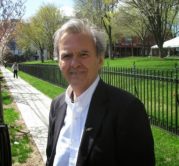Talking about the real credit union mission with Bill Bynum, CEO of Hope CU

Hope. That one word powerfully sums up the mission of Hope Credit Union, a Mississippi delta based community development credit union. And Hope is bringing financial hope to people across the deep south who may not have had a lot of that.
How does Hope do this and stay solvent? Listen up to what Bill Bynum, Hope’s CEO, has to say on that, as well as his provocative views about the real mission of credit unions in today’s America, the CFPB, and a lot more. This is a conversation that will rock you.
Q: Last time we talked you said that you were going all in on mobile banking because your members did not have home computers. Is that still true?
Bynum: That was a big part of the decision. We were one of the first financial institutions in Mississippi to embrace mobile technology because so many of our members didn’t have home computers. Mississippi and the deep south also have one of the highest rates of homes that don’t have a landline. People are using their cellphones for communications. We thought it was a great opportunity for us to use that technology to provide services to our members. It actually has gone better than I anticipated. We thought it would take longer than it did for people to become comfortable trusting their financial transactions over the phone. We’ve seen a steady increase in use of mobile banking. They use it for a variety of things, mostly to check their balances. That’s great. They make better financial decisions. The number of overdrafts has declined.
Q: How many members do you have and what’s the average family income?
Bynum: We are pushing 50,000 members. Disproportionately they are low income. The average household income of a mortgage borrower is less than $50,000. That’s someone buying a house. I’d suspect the average household income of all members is well south of that. 75% of our branches are in census tracts where the poverty level has been over 20% for three decades in a row. Entrenched, persistent poverty.
Q: How do you profitably serve that population? The big banks don’t think they can make money serving them.
Bynum: Banks were making money in those markets. Just not as much as they want to make. Mississippi is a rural, low income state. So are Alabama and Louisiana. These people need financial services. Payday lenders, check cashers, pawn shops are making money hand over fist. Charging these people rates that should be criminal. There’s a reasonable amount of profit to be made. I think the credit union business model is superior because we use the profits we generate to provide lower rates on loans and higher rates on deposits. We don’t take the profits and hand them to a handful of wealthy shareholders. Our members are our shareholders. I think it’s our business model that allows us to do what we do. It’s appropriate that credit unions are tax exempt. It helps our bottomline.
Q: I’m simplifying but in the US credit unions were created to serve a population banks did not want to serve. Working people. Mainly they made loans – home loans, car loans – and took in savings deposits. It seems to me a community development credit union such as yours is doing that mission. I’m not sure all credit unions are following that mission.
Bynum: Community development credit unions are clearly focused on serving people in communities that are underserved by other financial institutions, including other credit unions. Many of the credit unions we have merged with are small credit unions that were formed in response to predatory lending and lack of access to financial services. We merged with a credit union in Mississippi for timber workers who started it because the timber company charged exorbitant rates for loans. We merged with a credit union in Montgomery that served local teachers who needed better access to financial services. That is the history of credit unions and community development credit unions take that very seriously. That is at the core of our mission at Hope.
Q: Why aren’t there more community development credit unions?
Bynum: A lot are doing good work. A challenge [in creating more] is that we are not in a position to sell stock to raise capital. We have grown dramatically since the financial crisis. We are one of the fastest growing credit unions in the country, by rate of member growth and rate of asset growth. Growth requires that we have capital to keep the regulators satisfied and to protect our depositors. Typically credit unions grow their capital in a slow, organic way. When we are growing rapidly we need to find other ways to raise that capital. We use secondary capital, subordinated longterm debt. We are one of two credit unions in the country that use that resource more than anyone else. It’s complicated. Many small credit unions don’t have the infrastructure to take that on. We are fortunate we are able to do that. It’s not a simple strategy to pursue but we felt it was important.
Q: What other credit union does this?
Bynum: Self-Help. Between Self-Help and Hope we probably use more than half of the secondary capital credit unions use in the country.
Q: What’s your position on payday loans?
Bynum: Payday loans should be illegal. I served as chair of an advisory board at the Consumer Financial Protection Bureau and we were making strides at restricting these abusive financial practices. So many things are stacked against low income consumers. That agency was created to address that. It’s unfortunate it has stepped away from those issues.
Q: I’ll tell you what I think was unfortunate: a lot of credit unions from the beginning were enemies of that agency.
Bynum: It was misguided. I spoke against it. Financial institutions often have a knee jerk reaction to regulation. Well, we should be regulated because we are stewards of other people’s money and we need to do it in the right way. We saw what happened with the lack of regulation with the financial crisis. As credit unions we should be on the front line of consumer protection. It’s often used as a wolf whistle by the credit union trade associations to organize their members. It does not serve our members well.
Q: When you talk with credit union peers, what do they think about what you are doing?
Bynum: People wrote our epitaph – our eulogy – a long time ago. But we are in our 25th year now. It would behoove credit unions to look at what we are doing well and try to emulate it. The country is becoming more diverse. The communities we serve are increasingly becoming the majority. We have to be relevant to those populations. Financial institutions – credit unions included – ignore them at their own peril.
Q: How do you make money on a small dollar, payday type loan?
Bynum: We see it as a gateway, as an entry relationship. People will take out a $200 loan at a payday lender that costs $2000. We’ll refinance that loan at a reasonable rate. Then we’ll get that individual into a banking relationship that will help them. We don’t look at it as a single transaction. We look at it as part of a relationship.
Q: What kind of rate do you typically charge?
Bynum: 16%, maybe 18% for a small dollar loan. Sometimes it’s less. We have a very cool product that many of our members use called Borrow and Save. You need a $250 loan. We’ll write you a $500 loan where $250 goes into a savings account. When you pay that $500 you have $250 in a savings account that is there for you to tap when you have the next emergency. You now have a relationship with a depository that will help you meet your needs.
You ask how we do this and make money. Well, we do it to break even. Our mission isn’t making as much money as we can. Our mission is improving lives of people in some of the most distressed places in this country.A longer version of this conversation – in a podcast format – is available here for listening.

